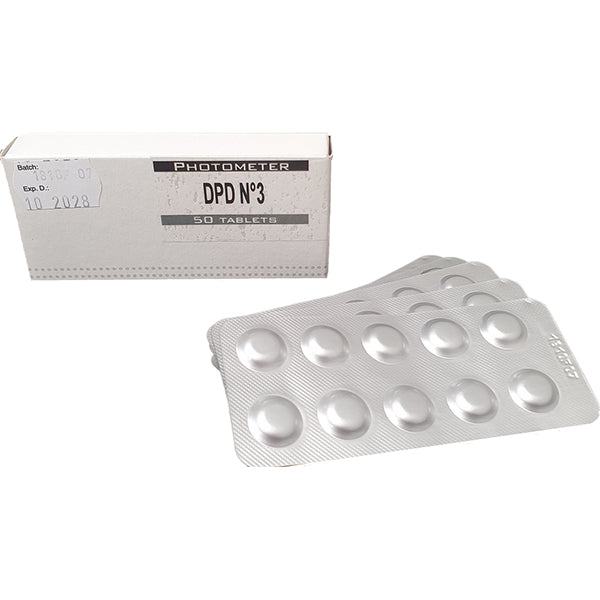AT Pool Services
Photometer DPD No3 (50 Tablets)
Photometer DPD No3 (50 Tablets)
Couldn't load pickup availability
Photometer DPD No1 - 50 Tablets
Chlorine (in the form of sodium hypochlorite, calcium hypochlorite, chlorine gas, chlorinated isocyanurates, ...) has prevailed worldwide as the leading disinfectant for swimming and bathing pools. To measure chlorine concentration existing in water under DIN EN 7393, 3 partial values are to be distinguished. 1.) free chlorine: chlorine that is present as hypochloric acid, hypochlorite ions, or dissolved, elementary, chlorine. 2.) combined chlorine: Portion of total chlorine which is present in the form of chloramines and all chlorinated derivatives of organic nitrogen compounds. 3.) total chlorine: Sum of the other two mentioned forms. While free chlorine immediately creates a disinfection effect, the disinfection potential of combined chlorine is highly limited. Chloramines are responsible for the smell of swimming pools and the irritation of human mucous membranes that lead to red eye. A member of this class of substances is nitrogen chloride which humans already perceive at a concentration of 0.02 mg/l. Free chlorine is measured according to the DPD N° 1 method. Here N,N-diallyl p-phenyl diamine (DPD), an indicator chemical, is oxidized by chlorine and discolors to red. The more intensive the discoloration, the more chlorine is present in the water. Photometric measurements or optical comparison with a colour scale allow the chlorine concentration to be measured. If a DPD N° 3 tablet is now added to this sample, then the combined chlorine will also be marked. The measured value now corresponds also to the total chlorine concentration. The concentration of combined chlorine corresponds to the difference between total chlorine and free chlorine. Since the slightest traces of the active chemicals in DPD N° 3 tablets lead to combined chlorine becoming active during the measurement, absolute care must be taken prior to the next DPD N° 1 measurement to sufficiently clean the measurement device thus avoiding false readings. The use of two differently calibrated vessels (one generally for measuring free chlorine and the other for measuring total chlorine values) is highly recommended.
Storage & Handling
- Store in a cool, dry place away from oxidizing and reducing agents, strong acid, alkalis, solvents and organic materials.
- Do not mix with other chemicals.
- Always wear suitable gloves and eye protection when handling.
Use biocides safely. Always read the label and product information before use.


